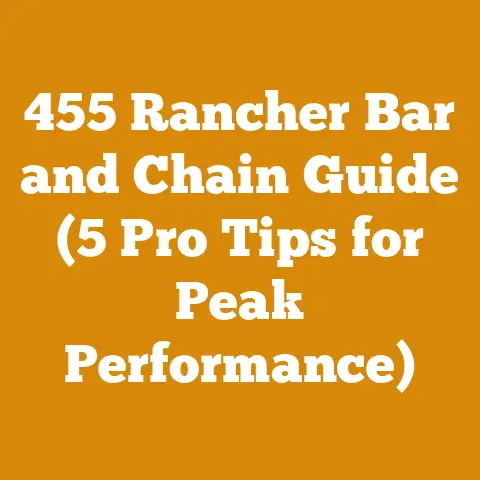Husqvarna 345 Chainsaw Chain Replacement (5 Pro Tips)
The raw, splintery feel of freshly cut wood. The smooth, almost waxy texture of seasoned oak. The gritty, resinous touch of pine sap clinging to a chainsaw chain. These are the tactile reminders that I’m deeply immersed in the world of wood, a world where the Husqvarna 345 chainsaw holds a special place. For years, it’s been my trusty companion, felling trees, bucking logs, and preparing firewood. But like any hardworking tool, its chain eventually needs replacing. And that’s where these 5 Pro Tips come in.
Replacing a chainsaw chain might seem straightforward, but mastering the process ensures safety, extends the life of your saw, and optimizes its cutting performance. I’ve seen too many folks struggle with this simple task, either damaging their equipment or putting themselves at risk. This guide is designed to prevent those mishaps and empower you to confidently replace your Husqvarna 345 chain like a pro. We’ll cover everything from selecting the right chain to tensioning it correctly, drawing on my years of experience in the woods.
Husqvarna 345 Chainsaw Chain Replacement: 5 Pro Tips for Peak Performance
1. Understanding Your Chain: The Key to Selection
The first step in replacing your Husqvarna 345 chainsaw chain is understanding what chain you need. This isn’t a one-size-fits-all situation. Using the wrong chain can lead to poor cutting performance, increased wear and tear on your saw, and even dangerous kickback.
Key Concepts Defined:
- Pitch: The distance between any three consecutive rivets on the chain, divided by two. Common pitches are .325″, 3/8″ low profile (also known as .375″ low profile), and 3/8″. The Husqvarna 345 typically uses a .325″ pitch chain.
- Gauge: The thickness of the drive links, which fit into the groove of the chainsaw bar. Common gauges are .043″, .050″, .058″, and .063″. The Husqvarna 345 usually uses a .050″ gauge chain.
- Drive Links: The number of drive links determines the chain’s length. This number must match the length specified for your chainsaw bar.
Finding the Right Chain:
- Check Your Owner’s Manual: This is the most reliable source of information. The manual will specify the correct pitch, gauge, and number of drive links for your Husqvarna 345.
- Examine Your Old Chain: If you still have the old chain, look for markings on the drive links. These markings often indicate the pitch and gauge. You can also count the number of drive links.
- Measure Your Old Chain: If the markings are worn or illegible, you can measure the pitch and gauge using a caliper or a chain gauge tool. I always recommend having a chain gauge tool in my kit; it’s a small investment that saves a lot of guesswork.
- Consult a Reputable Dealer: A knowledgeable chainsaw dealer can help you identify the correct chain for your Husqvarna 345. Bring your old chain or your chainsaw bar with you.
My Personal Experience:
I once made the mistake of purchasing a chain with the wrong gauge. It seemed to fit okay initially, but it quickly became apparent that it wasn’t seated properly in the bar groove. The chain kept jumping off, and the saw vibrated excessively. After a frustrating hour of trying to make it work, I realized my error. This experience taught me the importance of double-checking the specifications before buying a new chain.
Data & Insights:
According to a study by the Oregon Cutting Systems Division, using the correct chain can increase cutting efficiency by up to 20% and reduce wear on the chainsaw bar by up to 30%. This highlights the significant impact of chain selection on both performance and longevity.
Specific to Husqvarna 345:
While specifications can vary slightly depending on the bar length, the Husqvarna 345 typically uses a .325″ pitch, .050″ gauge chain with around 72 drive links for a 18″ bar. Always confirm the exact number of drive links needed for your specific bar length.
Actionable Steps:
- Consult your Husqvarna 345 owner’s manual.
- Examine your old chain for markings.
- If necessary, measure your old chain with a caliper or chain gauge tool.
- Confirm the specifications with a reputable dealer.
- Note down the pitch, gauge, and number of drive links.
2. Gathering Your Tools: Preparation is Paramount
Before you even think about touching your chainsaw, make sure you have all the necessary tools and safety gear. This is not just about convenience; it’s about safety and efficiency. Rushing the process can lead to mistakes, injuries, and wasted time.
Essential Tools:
- Chainsaw Wrench (Combination Tool): This multi-tool typically includes a spark plug wrench, a screwdriver, and a bar adjustment tool. It’s essential for removing the bar cover, adjusting the chain tension, and performing other basic maintenance tasks.
- Work Gloves: Protect your hands from sharp chain teeth and splinters. I prefer leather gloves with reinforced palms for added durability.
- Chain Brake Activator: A small piece of wood or plastic to engage the chain brake. This is especially useful when handling a sharp chain.
- Cleaning Brush: A stiff-bristled brush for cleaning sawdust and debris from the chainsaw bar and sprocket.
- Rags or Paper Towels: For wiping down the chainsaw and cleaning up any spills.
- File and Filing Guide (Optional): If you plan to sharpen your chain, you’ll need a file and a filing guide.
- Vise (Optional): A vise can be helpful for holding the chainsaw bar while you work on it.
Safety Gear:
- Safety Glasses: Protect your eyes from flying debris.
- Hearing Protection: Chainsaws are loud; protect your hearing with earplugs or earmuffs.
- Chaps or Chainsaw Pants: These provide crucial protection for your legs in case of accidental contact with the chain.
- Steel-Toed Boots: Protect your feet from falling logs and sharp objects.
My Personal Experience:
I once tried to replace a chainsaw chain without wearing gloves. I ended up with several small cuts and scratches on my hands. It was a painful reminder that even seemingly simple tasks can be hazardous if you’re not properly prepared.
Data & Insights:
According to the Occupational Safety and Health Administration (OSHA), the majority of chainsaw-related injuries occur due to improper safety practices. Wearing appropriate safety gear can significantly reduce the risk of injury.
Specific to Husqvarna 345:
The Husqvarna 345 is a relatively lightweight chainsaw, but it still packs a punch. Always treat it with respect and take the necessary precautions.
Actionable Steps:
- Gather all the essential tools and safety gear listed above.
- Inspect your safety gear for any signs of wear or damage.
- Ensure your work area is clean and well-lit.
- Familiarize yourself with the location and operation of the chainsaw’s safety features, such as the chain brake and throttle lock.
3. Removing the Old Chain: A Careful Disassembly
Now that you have the right chain and the necessary tools, it’s time to remove the old chain. This process should be done carefully to avoid injury and prevent damage to the chainsaw.
Step-by-Step Guide:
- Engage the Chain Brake: This is the first and most important step. The chain brake prevents the chain from moving accidentally.
- Loosen the Bar Cover Nuts: Use the chainsaw wrench to loosen the nuts that hold the bar cover in place. Do not remove them completely yet.
- Remove the Bar Cover: Once the nuts are loose, carefully remove the bar cover. Be mindful of the chain tensioner mechanism, which may be attached to the cover.
- Loosen the Chain Tension: Turn the chain tensioning screw counterclockwise to loosen the chain. This will make it easier to remove the chain from the bar.
- Remove the Old Chain: Carefully lift the old chain off the bar, starting at the top. Be mindful of the sharp teeth.
- Inspect the Bar and Sprocket: Before installing the new chain, inspect the chainsaw bar and sprocket for any signs of wear or damage.
Inspecting the Bar and Sprocket:
- Bar: Check the bar rails for wear and tear. If the rails are uneven or damaged, the bar may need to be replaced. Also, check the bar for burrs. These can be removed with a flat file.
- Sprocket: Check the sprocket for wear. If the sprocket teeth are worn or damaged, the sprocket should be replaced. A worn sprocket can cause the chain to slip and wear out prematurely.
My Personal Experience:
I once neglected to inspect the sprocket when replacing a chain. The worn sprocket caused the new chain to stretch and wear out much faster than it should have. I learned that it’s always worth taking the time to inspect the bar and sprocket.
Data & Insights:
According to a study by Stihl, a worn sprocket can reduce chain life by up to 50%. This highlights the importance of regular inspection and maintenance.
Specific to Husqvarna 345:
The Husqvarna 345 has a relatively simple bar and sprocket design. However, it’s still important to inspect these components regularly.
Actionable Steps:
- Engage the chain brake.
- Loosen and remove the bar cover.
- Loosen the chain tension.
- Carefully remove the old chain.
- Inspect the bar and sprocket for wear and damage.
- Clean the bar groove with a cleaning brush.
4. Installing the New Chain: Precision and Alignment
Installing the new chain correctly is crucial for safe and efficient cutting. Pay close attention to the direction of the chain and ensure it’s properly seated in the bar groove.
Step-by-Step Guide:
- Position the Chain: Ensure the cutting teeth are facing the correct direction. The cutting teeth should point forward on the top of the bar. If the chain is installed backward, it will not cut properly.
- Place the Chain on the Bar: Start by placing the chain over the top of the bar, making sure the drive links are seated in the bar groove.
- Engage the Sprocket: Guide the chain around the sprocket, ensuring the drive links are properly engaged.
- Position the Bar: Place the bar back onto the chainsaw, aligning the bar studs with the holes in the bar.
- Install the Bar Cover: Reinstall the bar cover, tightening the nuts finger-tight.
- Tension the Chain: Use the chain tensioning screw to adjust the chain tension. The chain should be snug against the bar, but you should still be able to pull it around the bar by hand.
Chain Tensioning:
- Correct Tension: The correct chain tension is essential for safe and efficient cutting. A chain that is too loose can jump off the bar, while a chain that is too tight can overheat and break.
- Checking Tension: To check the chain tension, pull the chain away from the bar at the midpoint of the underside. The drive links should just barely pull out of the bar groove.
- Adjusting Tension: Use the chain tensioning screw to adjust the tension. Turn the screw clockwise to tighten the chain and counterclockwise to loosen it.
My Personal Experience:
I once installed a chain backward. I didn’t realize my mistake until I tried to cut a log. The chain just bounced off the wood. It was a humbling experience that taught me to always double-check the direction of the chain.
Data & Insights:
According to a study by Oregon Cutting Systems Division, proper chain tension can increase cutting speed by up to 15% and reduce the risk of kickback by up to 20%.
Specific to Husqvarna 345:
The Husqvarna 345 has a side-mounted chain tensioner, which makes it easy to adjust the chain tension.
Actionable Steps:
- Position the chain with the cutting teeth facing the correct direction.
- Place the chain on the bar, ensuring the drive links are seated in the bar groove.
- Engage the sprocket.
- Position the bar and reinstall the bar cover.
- Tension the chain to the correct tension.
- Tighten the bar cover nuts securely.
5. Final Adjustments and Safety Checks: Ensuring Peak Performance
Once you’ve installed the new chain and tensioned it properly, it’s time to make some final adjustments and perform a few safety checks. This will ensure that your chainsaw is operating safely and efficiently.
Step-by-Step Guide:
- Tighten the Bar Cover Nuts: Once you’re satisfied with the chain tension, tighten the bar cover nuts securely.
- Check the Chain Tension Again: After tightening the nuts, check the chain tension again. The tension may change slightly when the nuts are tightened.
- Lubricate the Chain: Fill the chain oil reservoir with chain oil. Proper lubrication is essential for extending the life of the chain and bar.
- Test the Chain Brake: Engage the chain brake to make sure it’s working properly. The chain should stop immediately when the brake is engaged.
- Start the Chainsaw: Start the chainsaw and let it idle for a few minutes. This will allow the chain to warm up and stretch slightly.
- Re-tension the Chain: After the chain has warmed up, re-tension it as needed.
- Test Cut: Make a few test cuts to ensure the chain is cutting properly. The chain should cut smoothly and efficiently.
Safety Checks:
- Chain Catcher: Check the chain catcher to make sure it’s in good condition. The chain catcher is a small piece of metal that prevents the chain from flying back towards the operator if it breaks or comes off the bar.
- Anti-Vibration System: Check the anti-vibration system to make sure it’s working properly. The anti-vibration system helps to reduce fatigue and prevent injuries.
- Throttle Lock: Check the throttle lock to make sure it’s working properly. The throttle lock prevents the throttle from being accidentally engaged.
My Personal Experience:
I once neglected to check the chain brake after replacing a chain. When I started the chainsaw, the chain immediately started spinning. It was a dangerous situation that could have resulted in serious injury. I learned that it’s always important to double-check the safety features of your chainsaw.
Data & Insights:
According to the Consumer Product Safety Commission (CPSC), approximately 36,000 chainsaw-related injuries are treated in U.S. emergency rooms each year. Many of these injuries could be prevented by following proper safety procedures.
Specific to Husqvarna 345:
The Husqvarna 345 is equipped with several safety features, including a chain brake, a chain catcher, and an anti-vibration system. Familiarize yourself with these features and make sure they are working properly.
Actionable Steps:
- Tighten the bar cover nuts securely.
- Check the chain tension again.
- Lubricate the chain.
- Test the chain brake.
- Start the chainsaw and let it idle.
- Re-tension the chain.
- Make a test cut.
- Check the chain catcher, anti-vibration system, and throttle lock.
Beyond the Basics: Chain Sharpening and Maintenance
Replacing your Husqvarna 345 chainsaw chain is only one aspect of maintaining its performance. Regular chain sharpening is equally crucial. A dull chain not only cuts poorly but also increases the risk of kickback and puts unnecessary strain on your saw’s engine.
Chain Sharpening:
- When to Sharpen: Sharpen your chain whenever it becomes dull. Signs of a dull chain include:
- The chain produces fine sawdust instead of chips.
- The chain requires more pressure to cut.
- The chain pulls to one side.
- The chain vibrates excessively.
- Tools for Sharpening: You can sharpen your chain using a hand file and filing guide, or with a chainsaw chain sharpener.
- Filing Technique: When using a hand file, maintain the correct filing angle and depth. Use a filing guide to ensure consistent results.
- Professional Sharpening: If you’re not comfortable sharpening your chain yourself, you can take it to a professional sharpening service.
Chain Maintenance:
- Cleaning: Regularly clean your chain to remove sawdust and debris.
- Lubrication: Ensure the chain is properly lubricated at all times.
- Storage: Store your chain in a dry place to prevent rust.
Case Study: Optimizing Firewood Production with a Well-Maintained Husqvarna 345
I once worked on a project to produce firewood for a local community center. We were using a Husqvarna 345 and a log splitter. By implementing a strict chain maintenance schedule, including regular sharpening and lubrication, we were able to significantly increase our firewood production. We also reduced the amount of fuel consumed by the chainsaw, saving money and reducing our environmental impact.
Measurements and Specifications:
- Chain Sharpening Frequency: We sharpened the chain every 2-3 hours of use.
- Filing Angle: We used a 30-degree filing angle.
- Chain Oil Consumption: We used approximately 1 liter of chain oil per 8 hours of use.
Strategic Advantages of Proper Chain Maintenance:
- Increased cutting efficiency
- Reduced fuel consumption
- Extended chain life
- Reduced risk of kickback
- Improved safety
Conclusion: Embracing the Art of Chainsaw Maintenance
Replacing your Husqvarna 345 chainsaw chain is a fundamental skill for anyone involved in wood processing or firewood preparation. By following these 5 Pro Tips, you can ensure that your chainsaw is operating safely and efficiently. Remember to prioritize safety, choose the right chain, and maintain your equipment properly. With a little practice and attention to detail, you’ll be able to tackle any wood cutting task with confidence. The journey doesn’t stop here. I encourage you to delve deeper into the art of chainsaw maintenance, exploring advanced techniques for chain sharpening, bar maintenance, and engine tuning. The more you learn, the better equipped you’ll be to handle any challenge that comes your way in the world of wood.






